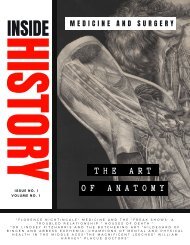Inside History: A History of Film (Sample)
Join Inside History as we talk a closer look at The History of Film. From its humble origins to creating some of the world's most iconic moments. Along the way we will also look at how some films can flop at the box office only to become classics later, explain why Casablanca just might be the greatest War film of all time and how the silent era inspired even modern film makers. From Lon Chaney to Marilyn Monroe and John Williams we explore not only what happened on screen but also those behind the scenes who have played a part in some of the greatest movies of all time. With essays on: George Melies, Casablanca, The Cabinet of Dr Caligari, Psycho, Leni Riefenstahl, Warner Brothers, Ealing Studios, Lon Chaney, Frankenstein and much more. Full edition is available at www.insidehistorymagazine.ecwid.com
Join Inside History as we talk a closer look at The History of Film. From its humble origins to creating some of the world's most iconic moments. Along the way we will also look at how some films can flop at the box office only to become classics later, explain why Casablanca just might be the greatest War film of all time and how the silent era inspired even modern film makers.
From Lon Chaney to Marilyn Monroe and John Williams we explore not only what happened on screen but also those behind the scenes who have played a part in some of the greatest movies of all time.
With essays on:
George Melies, Casablanca, The Cabinet of Dr Caligari, Psycho, Leni Riefenstahl, Warner Brothers, Ealing Studios, Lon Chaney, Frankenstein and much more.
Full edition is available at www.insidehistorymagazine.ecwid.com
Create successful ePaper yourself
Turn your PDF publications into a flip-book with our unique Google optimized e-Paper software.
these emotions before such an unemotional thing as a
camera. A very ordinary person indeed can act before a
crowded house of interested men and women, but it
takes a genius to do so with real feeling on a moving
picture stage.”
In her work, Lawrence was billed as the ‘Biograph Girl’,
following the practice of anonymity whereby stars were
known by the names of the studios they were contracted
to. Florence Turner, who was in the ascendancy at a
similar time to Lawrence, was, for example, the
‘Vitagraph Girl’. After her fans clamoured to know her
real name, Lawrence became the first major star to be
identified, and soon the actress was able to command
twice the usual Biograph salary.
Upon later joining Carl Laemmle’s Independent Motion
Picture Company (IMP), the actress became embroiled in
the infamous publicity stunt, which led her to make
history once again as the subject of the first ever film
publicity tour. Laemmle timed the truth of his own lie
about Lawrence’s death to the release of her latest
project. On 25 March 1910, the star was paraded in St
Louis with another actor, King Baggot. Crowds – who had
been warmed up by Laemmle’s publicity blitz in the local
newspapers – rushed towards Lawrence, in one version
of events pulling at her dress and ripping off its buttons.
The actress was caught up in the crush and was said to
have become disturbed and frightened. This all came
after the bizarre experience of reading about her own
death in a newspaper. In her autobiography Growing Up
with the Movies – serialised in four issues of Photoplay
between November 1914 and February 1915 – Lawrence
described this as “the most astounding adventure of my
life […] half-consciously I glanced at the paper and was
startled to see several likenesses of myself staring me in
the face, topped by a flamboyant headline announcing
my tragic end beneath the wheels of a speeding motor
car. To say that I was stunned would be putting it
mildly”. She added: “I shall never forget that trip to St.
Louis. It simply overwhelmed me.”
After working at IMP for almost a year, making about 50
films, Lawrence collaborated with other studios including
the Victor Company, which she founded with her
husband Harry Solter in 1912, with support from
Laemmle. In another first, the company was one of the
earliest in America to be led by a woman. But Victor
would only last for a few years, and Lawrence’s career
was beginning to stall. Her difficulties were compounded
by ill mental and physical health. This included an on-set
accident during filming for Pawns of Destiny in spring
1914. Solter – who also worked in film, including
directing his wife in multiple productions – tasked her
with a scene in which she carried her male co-star down
a flight of stairs, as part of a narrative where their
characters were affected by a fire. While the nature of
Lawrence’s injuries is unclear, it appears she sustained a
Bioscope actress Florence Lawrence, c. 1908. (Public Domain)
back injury from the stunt. Not long afterwards, the
couple’s volatile marriage fell apart, and they instigated
divorce proceedings in 1916, following a previous split in
1912. Solter would fall ill in the spring of 1920, and
he died after experiencing a severe stroke. Lawrence
remarried twice, to automobile salesman and former
soldier Charles B. Woodring, and the physically abusive
Henry Bolton, who she divorced after a few months of
marriage.
The former star’s attempts to resurrect her career during
the 1920s foundered, with efforts including having
cosmetic surgery on her nose seeming to have little
effect. Lawrence branched out into business, opening
Hollywood Cosmetics with Woodring, and assisting her
mother with her own entrepreneurial ideas. Both sides
attempted to capitalise on Lawrence’s once brightly held
fame, as Brown has discussed. Hollywood Cosmetics’
range included products with the actress’s image on the
cover, and Lotta Lawrence drew on her daughter’s
career in marketing materials for her ventures. But the
business world proved to be as tough to crack as the
movies, and Lawrence was forced to return to vaudeville
shows. In the mid-1930s, she was able to gain some
work in the ‘Talkies’, making $75 dollars a week for small
parts at Metro-Goldwyn-Mayer. Just a few years later, in
late December 1938, Lawrence died. She had taken her
own life at the age of 52. The American media paid little
attention – as the historian Greg Jenner has noted, the
public only cared when Florence Lawrence died the first
time. The actress’s legacy has been one of obscurity,
alleviated to an extent by the efforts of film scholars. But
as the first major film celebrity, star of hundreds of silent
films, and a producer and studio founder in her own
right, she deserves a place in Hollywood history.
14 INSIDE HISTORY

















